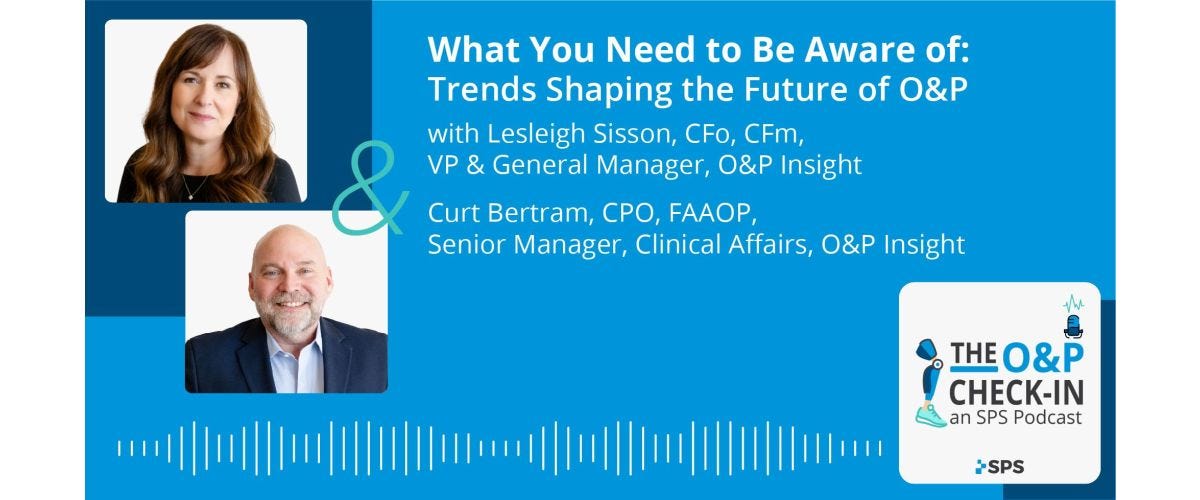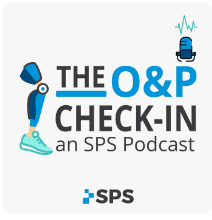In this episode of The O&P Check-in: an SPS Podcast, we spoke with O&P Insight’s Vice President and General Manager, Lesleigh Sisson, CFo, CFm, and Senior Manager, Clinical Affairs, Curt Bertram, CPO, FAAOP about the trends shaping the O&P industry, from reimbursement to consolidation.
The following includes an excerpt from our conversation, edited for length and clarity. Click here to listen to the full interview.
The O&P Check-in: an SPS Podcast unpacks trends and stories from the tight-knit community of O&P professionals. From patient care to technology, best practices, and regulations, this podcast features topics that help you stay current.
One trend at the top of many O&P professionals’ minds is reimbursement. Could you share how Medicare policy has shaped the O&P market and how O&P has influenced policy?
Medicare policy has always shaped healthcare, and O&P in particular, but especially starting in 2011 when the OIG report about aberrant billing practices of lower limb prostheses came out, which influenced the first-year physician letter regarding prostheses. Then, the RAC audits happened in 2012, which rocked the O&P world because we had never been held accountable before for physician medical records relating to the claims that we billed. Before that, we as an industry always thought that a detailed written order and our records were sufficient for medical records to justify prosthetic and orthotic devices. That's when the world changed for us, and we had to have medical records from the ordering physician to corroborate the claim that we sent to Medicare.
Another issue that came up in April 2022 was the upper limb prosthetic coding advisory article that came out as a joint article from the DME MAC and the PDAC. This hit our industry hard. As we all know, there's no upper limb LCD or policy article, so this was intended to be a correct coding guidance article that sort of mirrored lower limb prosthetics. However, as we analyze this as a profession and as our associations - the O&P Alliance, the Academy, AOPA, NAAOP - they all looked at this and said, “Oh, this is not what we really wanted.” The DME MAC and the PDAC are charged with correctly coding tasks and providing that to our industry. When we looked at it, we thought, well, this is going to be very unfortunate for upper limb amputees, specifically those who have partial hand amputations.
Our associations got together and rebutted this policy article, providing a lot of evidence and comments. It took until about March of 2023, but it was finally retired. The unfortunate legacy is that some private and commercial payers may adopt some of this language into their policies moving forward or use it to deny certain claims. The good news is that CMS retired this article.
As we move forward, not only do CMS and Medicare shape what we do through this type of action, but we actually have a voice. Through our associations, we can rebut this type of perceived negative impact on our industry and retain the ability to provide quality care to our patients.
What trends are you seeing in the O&P industry regarding digital workflow and automation?
As an industry, we've struggled with digital workflow on the clinical side, and we've lacked early adopters. Lesleigh and I were talking recently about how we in our industry stick to old paradigms regarding fabrication because it is a known quantity. We know what we know. It's easy and efficient for us. Take a solid ankle AFO, for example. I can cast the patient, fill the plaster cast, modify it, pull the plastic, get it done the same day, and I'm 100% in control. Now, when I move to a digital workflow, I must learn a new technology. I have a certain expenditure on the cost of goods and a capital expenditure on equipment. I have to either learn how to modify it myself or rely on a central location that can modify and rectify my cast. Then, typically, I’m relying on a central fabrication facility to produce it. We know what we know and tend to be comfortable with that because we can control so many factors. When it comes to early adoption, we must learn, spend money, and trust and develop those relationships and partners that will enable us to adopt that new technology. We're seeing more adoption of digital workflow in the industry now. It makes us very efficient, but ultimately, it allows us to see more patients.
To hear the entire conversation, click here:
To learn more about O&P Insight, visit oandpinsight.com. You can register for their upcoming Lead the Way 2024 Conference here.
Follow O&P Insight on social media:


